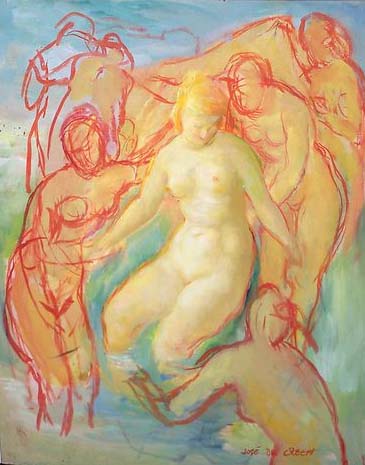

JOSE DE CREEFT
"NUDES"
OIL ON CANVASBOARD, SIGNED
AMERICAN, C.1960
20 X 16 INCHES
Jose De Creeft was born in Guadalajara, Spain in 1884. Interested in sculpture as a child, De Creeft made and sold works in the streets as a teenager. Before leaving for Paris in 1905 to study further, he was apprenticed, in 1895, to a maker of religious images; in 1898, to the firm of Masriera and Campin; and in 1900, to the government's official sculptor, Don Augustin Querol. De Creeft left for Paris in 1905, studying briefly at the Academie Julian and in 1911, attended the Maison Greber to learn to reproduce in stone works initially made in clay and plaster. De Creeft broke with his training in modeling and casting in 1915 and turned to direct carving of wood and stone. Through direct carving, his desire to preserve the natural qualities of the material met his interests in the sculptural arts of Pre-Columbian America and Africa. Respected in academic circles, De Creeft was commissioned in 1918 to sculpt a granite war memorial in Saugues (Puy de Dome) dedicated to the French foot soldier, "Le Poilu." In 1925, and for a short time after, he experimented with assemblage techniques, but De Creeft remained a carver. From 1927 to 1929, he created two hundred stone carvings for Roberto Romonje's Forteleza in Majorca, Spain. De Creeft began exhibiting regularly in modernist exhibitions such as the Salon d'Automne between 1919-28. He emigrated to America in 1929 with his reputation as a direct carver already secure and had his first solo exhibition at Feragil Galleries in New York. De Creeft helped to popularize both direct-carving methods and, beginning the following year, the use of ballpeen hammers to make three-dimensional forms from lead sheets ("Les Deux Amis," 1941, Norton Gallery, and School of Art, West Palm Beach, Florida). In styles ranging from Art Moderne to Expressionism, he projected an opulence of gesture. De Creeft was also a teacher of sculpture in New York City at the New School of Social Research, 1932-39; the Art Students League, 1944-48; and Black Mountain College, the summer of 1944. De Creeft earned United States citizenship in 1940. In 1951, Jose De Creeft sculpted the "Poet" for Philadelphia's Fairmount Park Association. De Creeft never lost his interest in casting despite the strong appeal of direct carving. New Being is a brass casting that retains the rough textures of the red Spanish marble version (Kingsborough Community College, Brooklyn, New York). New Being possesses a distinctive Pre-Columbian character, possibly the inspiration of the Mayan Chac Mool figures at Chichen Itza, which also influenced Henry Moore. De Creeft once said, "Sculpture is the creation of three-dimensional form in space. In my opinion, the most fundamental principle required to obtain that end is the use of massive volume and contour. I cannot believe that sculpture is a mechanical toy, a feat of engineering, or a series of spaces in material." |